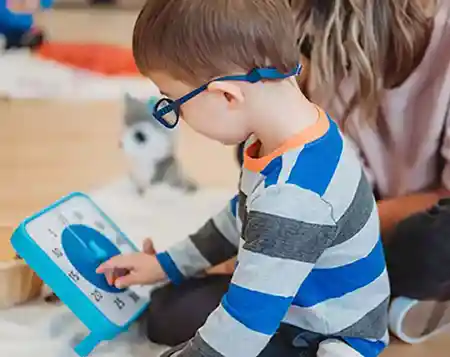Simple Shifts: Making Time Visible for Young Learners

Ever notice how time feels different to children? Five minutes of cleanup can feel like forever, while an hour at the block center feels like the blink of an eye. For young children, the concept of time is slippery, invisible, and hard to hold onto. That’s where visual timers step in. They make time something you can see.
Whether it’s a sand timer, a big digital countdown, or a color-changing app, visual timers take the mystery out of “how long” and turn it into something concrete. And while they help all children, they can be especially powerful for children with ADHD, autism, or other learning differences.
Start Small: Introducing Timers
Like any tool, timers need an introduction before they become routine. Try:
- • Practice without pressure. Introduce timers in low-stakes, no-pressure situations so children can explore the tool without added pressure.
- • Modeling it yourself. Narrate: “We’ll play until the red disappears, then it’s snack time.”
- • Making it a game. Can we put the blocks away before the sand runs out?
- • Keeping it steady. Use the same phrases each time so it feels predictable, not like a surprise.
- • Shared and individual. Consider using a large classroom timer alongside smaller, hand-held timers for children who benefit from their own personal version.
Agency in Action
Timers aren’t about control, they’re about giving kids ownership. Over time, you might notice:
- • A child glancing at the timer instead of asking, “Is it time yet?” for the 12th time.
- • A small group setting the timer themselves to take turns.
- • A student making a choice: “I’ll finish my drawing before the red is gone.”
That’s self-regulation in action. Less nudging from us, more independence for them.
Looping Families In
Families might not know what these tools look like in practice, so a quick explanation helps. Try:
- • Sharing the why. “Timers help children anticipate transitions and feel more in control.”
- • Snapping a photo or share a video. Show families how children use them in real time.
- • Offering ideas. Timers at home can make routines like teeth brushing, screen time, or “shoes on” smoother.
Small Shifts, Big Impact
Visual timers don’t just smooth transitions. They reduce anxiety, promote fairness, and hand children real tools for self-management. When time is visible, children can navigate it with more confidence.
Suggested Products

Christine Murray is an Early Childhood Education Specialist with Becker’s Education Team.
As an educator, coach and leader, Christine is inspired by the curiosity, joy and wonder that children so generously model for us. She earned her M.A. in Innovative Early Childhood Education at the University of Colorado Denver and loves collaborating with and supporting others in the field. Grounded in relationships and guided by empathy, Christine is always learning, connecting and creating.







